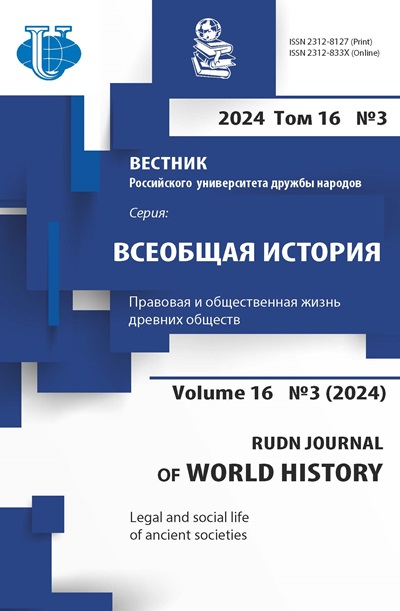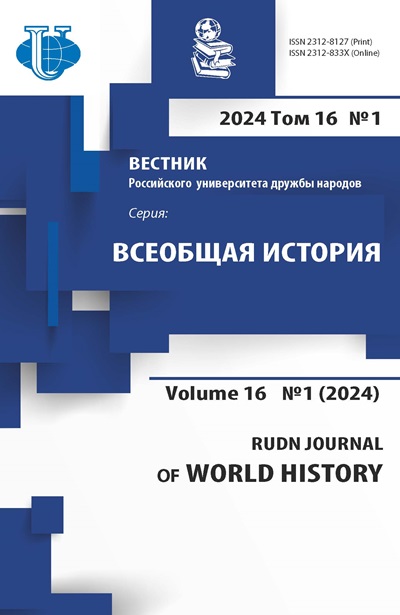Description of nomadic turkic tribes of eastern Desht-i Qipcha-q in Muslim Writings of the First Half of the 13th century: on the Problem of Historiographical Continuity
- Authors: Timokhin D.M.1, Tishin V.V.2
-
Affiliations:
- Institute of Oriental studies of the RAS
- Institute for Mongolian, Buddhist and Tibetan Studies of the Siberian Branch of the RAS
- Issue: Vol 16, No 1 (2024)
- Pages: 105-118
- Section: HISTORIOGRAPHICAL STUDY
- URL: https://journals.rudn.ru/world-history/article/view/38728
- DOI: https://doi.org/10.22363/2312-8127-2024-16-1-105-118
- EDN: https://elibrary.ru/HJSNJA
Cite item
Full Text
Abstract
The historical work of the first half of the 13th century “Jawāmi‘ ul-Hikāyāt wa Lawāmi‘ ul-Riwāyāt” (“A Collection of Anekdotes and Brilliant Stories”), written by Sayyīd al-Dīn Muḥammad ‘Awfī, includes a significant section on the history of the nomadic Turkic tribes of Desht-i Qipchāq. Despite the fact that this monument is well known to researchers, this section from “Jawāmi‘ ul-Hikāyāt...” has never been fully translated into Russian. It was published in the first volume of “Turkestan in the Era of the Mongol invasion” by V.V. Barthold on the basis of several handwritten lists. The purpose of this study is, on the one hand, to acquaint researchers with the content of this section from the work of Muḥammad ‘Awfī, and on the other hand, to highlight its historiographical connection with earlier monuments of Muslim historiography. The conducted research once again demonstrated the fact that the basis for the section “Jawāmi‘ ul-Hikāyāt...”, dedicated to the nomadic Turkic tribes of Desht-i Qipchāq, was the work of the first half of the XII century. “Kitāb Ṭabā’i‘ al-Ḥayawān” (“On the Nature of Animals”) by an outstanding Muslim scientist - Sharaf al-Zamān Ṭāhir al-Marwazī. For his part, Muḥammad ‘Awfī did not fully cite the story of an earlier author: the part of the text “Ṭabā’i‘ al-Ḥayawān”, where it was about the tribal union of the Qïrqïz, attracted his greatest attention. Other nomadic Turkic tribes in “Jawāmi‘ ul-Hikāyāt...” are described in much less detail, sometimes with obvious mistakes and distortions, which were made either by Muḥammad ‘Awfī himself, or by the copyist of his work, when transmitting toponyms and ethnonyms borrowed from the text of “Ṭabā’i‘ al-Ḥayawān”. Thus, the evolution of the narrative about the nomadic Turkic tribes of Desht-i Qipchāq in Muslim historiography of the 12th - early 13th centuries is quite clearly traced when comparing these two sections from “Ṭabā’i‘ alḤayawān” by al-Marwazī and “Jawāmi‘ ul-Hikāyāt...” by Muḥammad ‘Awfī.
About the authors
Dmitriy Mikhaylovich Timokhin
Institute of Oriental studies of the RAS
Email: horezm83@mail.ru
ORCID iD: 0000-0002-9093-5269
Phd in History, Senior Researcher, Department of Oriental History
Moscow, 107031, Russian FederationVladimir Vladimirovich Tishin
Institute for Mongolian, Buddhist and Tibetan Studies of the Siberian Branch of the RAS
Author for correspondence.
Email: tihij-511@mail.ru
ORCID iD: 0000-0001-7344-0996
Phd in History, Senior Researcher
Ulan-Ude, 670047, Russian FederationReferences
- Novosel’cev A.P. Hazarskoe gosudarstvo i ego rol’ v istorii Vostochnoj Evropy i Kavkaza [The Khazar State and its role in the history of Eastern Europe and the Caucasus]. M.: Nauka; 1990. (In Rus.)
- Timohin DM., Tishin VV. Spisok tyurkskih plemen v sochinenii Fahr-e Modabbera [List of Turkic tribes in the composition of Fakhr-e Modabber] // Zolotoordynskoe nasledie. Materialy VIΙ Mezhdunarodnogo Zolotoordynskogo Foruma «Civilizacionnoe znachenie prinyatiya Islama Volzhskoj Bulgariej i Zolotoj Ordoj: integracionnye processy v srednevekovoj istorii Rossii», Kazan’, 14–16 dekabrya 2022 g. Vypusk 5. Kazan’: Institutistoriiim. SH. Mardzhani AN RT; 2023, p. 38–50. (In Rus.)
- Bartol’d VV. Sochineniya. T. I: Turkestan v epohu mongol’skogonashestviya [Turkestan during the Mongol invasion]. M.: Nauka; 1963. (In Russ.).
- Lubābu’l-Albāb of Muhammad ‘Awfi / Edited in the original Persian. Pt I, with indices, Persian and English prefaces, and notes, critical and historical, in Persian, by E.G. Browne and Mirza Muḥammad ibn ‘Abdu ‘l-Wahhab-i-Qazwini. Leyden: E.J. Brill; London, Luzac & Co.; 1906. (In Pers.)
- Bartol’d VV. Turkestan v epohu mongol’skogo nashestviya. Chast 2. Issledovanie [Turkestan in the era of the Mongol invasion. Part 2. Research]. SPb.: Tip. V. Kirshbauma; 1900. (In Russ.).
- Elliot HM. The History of India, as Told by Its Own Historians. Vol. II, Muhammadan period. Ed. by J. Dowson. London: Trübner & Co.; 1869.
- Matīnī J. ʿAwfī Sadīd-al-Dīn. In: The Encyclopaedia Iranica. London: Brill, 1989 Vol. III, Fasc. 2. P. 117–118.
- Bejsembiev TK. Izvestiya «Dzhavami‛ al-hikajat» al-‘Awfi o Samanidah, Karahanidah, Sel’dzhukidah i Horezmshahah [News of «Javami’ al-hikayat» al-‘Awfi about Samanids, Karakhanis, Seljukids and Khorezmshahs].Zolotoordynskoe obozrenie. 2015;(1–2):178–206, 197–230. (In Russ.).
- Bartol’d VV. Turkestan v epohu mongol’skogo nashestviya. Chast I. Teksty [Turkestan in the era of the Mongol invasion. Part one. Texts]. SPb.: Tipografiya Imperatorskoj Akademii nauk; 1898. (In Pers. and Arab.)
- Marquart J. Über das Volkstum der Komanen. In: Bang W., Marquart J. Ostturkische Dialektstudien.Berlin: Weidmannsche Buchhandlung, 1914, p. 25–238.
- Marquart J. Skizzen zur geschichtlichen Völkerkunde von Mittelasien und Sibirien. Ostasiatische Zeitschrift. 1919–1920. Bd. VIII. Festschrift für Friedrich Hirthzuseinem 75. geburtstag 16. april 1920. P. 289–299.
- Şeşen R. İslam Coğrafyacılarına Göre Türkler ve Türk Ülkeleri. 2. baskı. Ankara: TürkTarihKurumuBasimevi; 2001. (In Turk.)
- Golden PB. An Introduction to the History of the Turkic Peoples: Ethnogenesis and StateFormation in Medieval and Early Modern Eurasia and the Middle East. –Wiesbaden: Otto Harrassowitz; 1992.
- Sharaf al-Zamān Ṭāhir Marvazī. On China, Turks and India. Arabic Text (circa A.D. 1120) with the English translaton and commentary by V. Minorsky. London: The Royal Asiatic Society; 1942.
- Gardīzī Abu Sa‘id. Zajn al-ahbar. Ukrashenie izvestij. Razdel ob istorii Horasana [Zayn al-akhbār. Decoration of the news. Section about the history of Khorasan]. Tashkent: Fan;1991. (In Rus.)
- Kitab Zainu’l-Akhbar. Composed by Abu Sa’id ‘Abdu’l-Ḥayy B. aḍ-Ḍahhak B. Maḥmud Gardīzī about A.H. 440. Edited by Muhammad Nazim. Berlin: Orientalischer Zeitschriftenverlag Iranschähr; 1928. (In Pers.)
- Timohin DM. Upominaniya titulatury tyurkskih pravitelej pri opisanii istorii Gaznevidov v «Taba’i’ al-Hajjavan» al-Marvazi [Referencesto the titles of the Turkic rulers when describing the history of the Ghaznavids in «Taba’i’ al-Hajjavan» by al-Marwazi] // Rossijsko-aziatskij pravovoj zhurnal. 2021;(3):60–65. (In Rus.)
- Timohin DM. Svedeniya o sultane Mahmude Gaznevi v sochinenii Al-Marvazi «Taba’i‘ alHajjavan» [Information about Sultan Mahmud Ghaznevi in al-Marwazi’s work «Taba’i‘ alHajjavan»]. Vestnik Buryatskogo nauchnogo centra SO RAN. 2022;1(45):95–103. (In Rus.). https://doi.org/10.31554/2222-9175-2022-45-95-102
- Bartol’d VV. Dvenadcat’ lekcij po istorii turkskih narodov Srednej Azii [Twelve lectures on the history of the Turkish peoples of Central Asia]. In: Bartol’d V.V. Sochineniya. T. 5. Raboty po istorii i filologii tyurkskih I mongol’skih narodov. M.: Glavnaya redakciya vostochnoj literatury; 1968, p. 19–195. (In Rus.)
- Martinez AP. Gardīzī’s Two Chapters on the Turks. Archivum Eurasiae Medii Aevi. 1982;(II):109–217.
- Bartol’d VV. Izvlechenie iz sochineniya Gardīzī Zajn al-aḫbār.Prilozhenie k «Otchetu o poezdke v Srednyuyu Aziyu s nauchnoyu cel’yu. 1893–1894 gg.» [Extract from the work of Gardīzī Zayn al-akhbār> Appendix to the «Report on a trip to Central Asia with a scientific purpose. 1893–1894.»]. In: Bartol’d V.V. Sochineniya: v 9 t. M.: Nauka, 1973. T. VIII. Raboty po istochnikovedeniyu. P. 23–62. (In Rus.)
- İnan A. Tarihte ve Bügün Şamanizm: Materyallerve Araştırmalar. 3. baskı. Ankara: TürkTarihKurumu; 1986. (In Turk.)
- Boyle JA. Turkish and Mongol Shamanism in the Middle Ages. Folklore. 1972;83(3):177–193.













